tire size NISSAN QASHQAI 2017 Owner´s Manual
[x] Cancel search | Manufacturer: NISSAN, Model Year: 2017, Model line: QASHQAI, Model: NISSAN QASHQAI 2017Pages: 508, PDF Size: 2.68 MB
Page 453 of 508
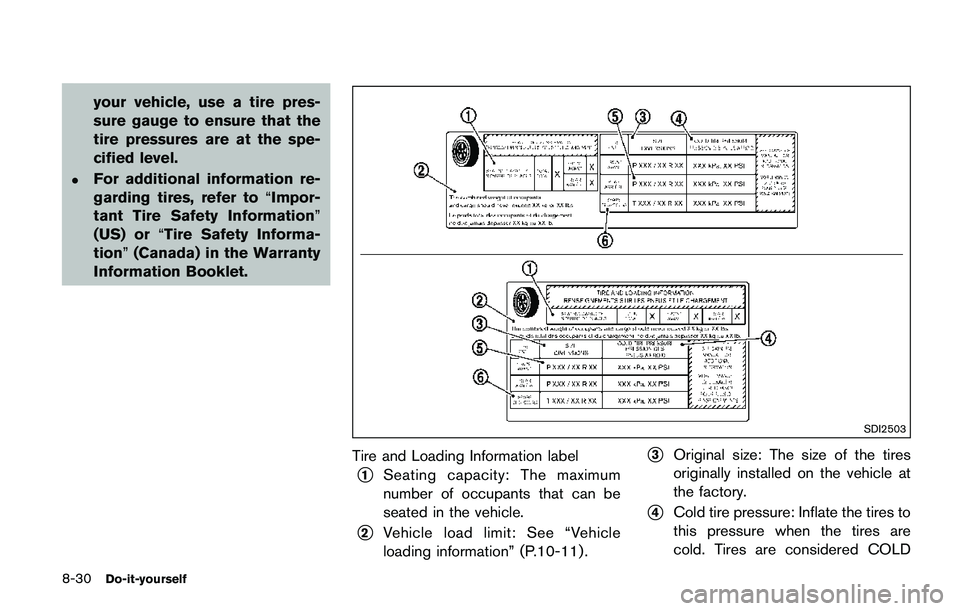
8-30Do-it-yourself
your vehicle, use a tire pres-
sure gauge to ensure that the
tire pressures are at the spe-
cified level.
.For additional information re-
garding tires, refer to“Impor-
tant Tire Safety Information”
(US) or“Tire Safety Informa-
tion”(Canada) in the Warranty
Information Booklet.
SDI2503
Tire and Loading Information label
*1Seating capacity: The maximum
number of occupants that can be
seated in the vehicle.
*2Vehicle load limit: See “Vehicle
loading information” (P.10-11) .
*3Original size: The size of the tires
originally installed on the vehicle at
the factory.
*4Cold tire pressure: Inflate the tires to
this pressure when the tires are
cold. Tires are considered COLD
Page 454 of 508
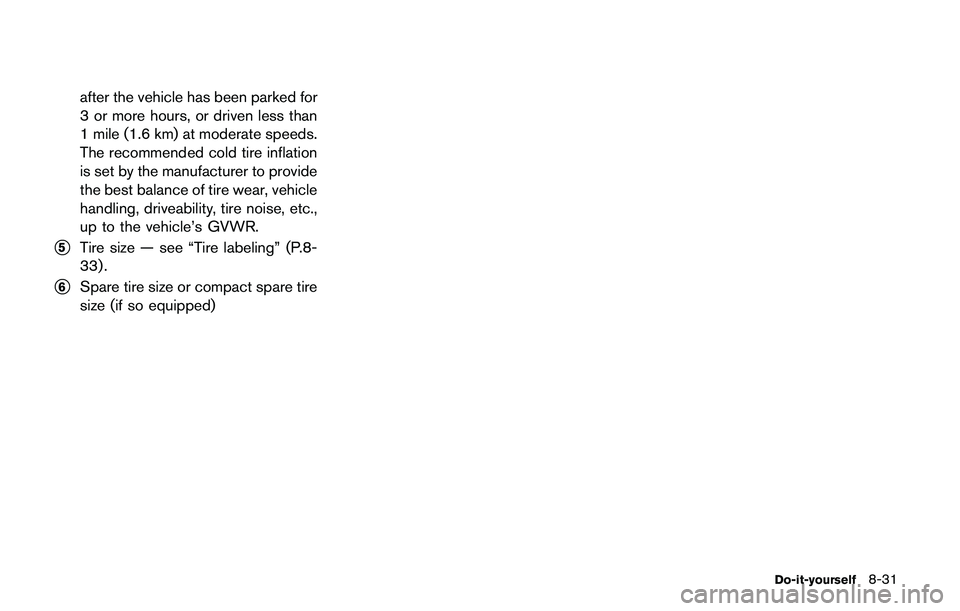
after the vehicle has been parked for
3 or more hours, or driven less than
1 mile (1.6 km) at moderate speeds.
The recommended cold tire inflation
is set by the manufacturer to provide
the best balance of tire wear, vehicle
handling, driveability, tire noise, etc.,
up to the vehicle’s GVWR.
*5Tire size — see “Tire labeling” (P.8-
33) .
*6Spare tire size or compact spare tire
size (if so equipped)
Do-it-yourself8-31
Page 456 of 508
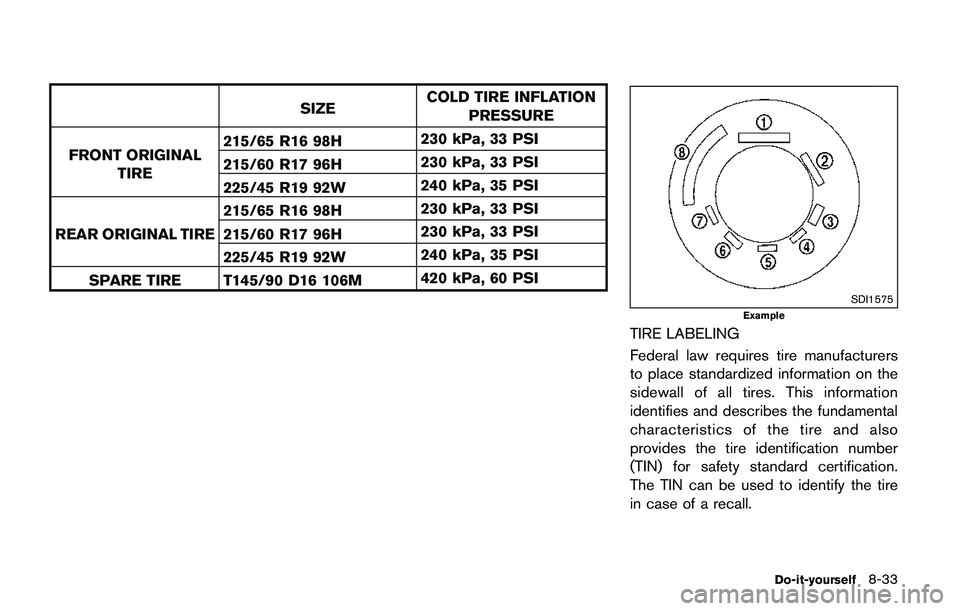
SIZECOLD TIRE INFLATION
PRESSURE
FRONT ORIGINAL
TIRE215/65 R16 98H230 kPa, 33 PSI
215/60 R17 96H230 kPa, 33 PSI
225/45 R19 92W240 kPa, 35 PSI
REAR ORIGINAL TIRE215/65 R16 98H230 kPa, 33 PSI
215/60 R17 96H230 kPa, 33 PSI
225/45 R19 92W240 kPa, 35 PSI
SPARE TIRE T145/90 D16 106M420 kPa, 60 PSI
SDI1575
Example
TIRE LABELING
Federal law requires tire manufacturers
to place standardized information on the
sidewall of all tires. This information
identifies and describes the fundamental
characteristics of the tire and also
provides the tire identification number
(TIN) for safety standard certification.
The TIN can be used to identify the tire
in case of a recall.
Do-it-yourself8-33
Page 457 of 508
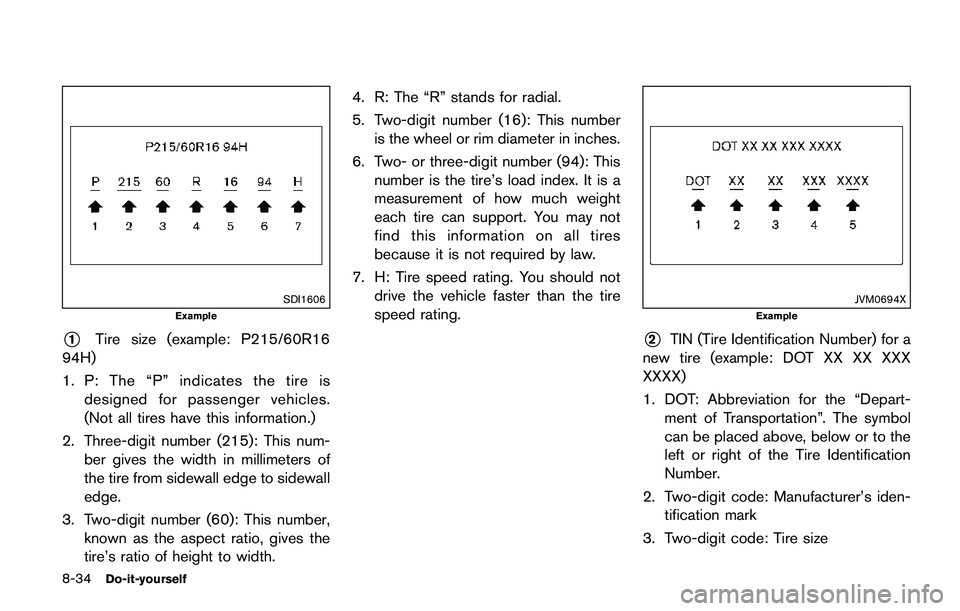
8-34Do-it-yourself
SDI1606
Example
*1Tire size (example: P215/60R16
94H)
1. P: The “P” indicates the tire is
designed for passenger vehicles.
(Not all tires have this information.)
2. Three-digit number (215): This num-
ber gives the width in millimeters of
the tire from sidewall edge to sidewall
edge.
3. Two-digit number (60): This number,
known as the aspect ratio, gives the
tire’s ratio of height to width.4. R: The “R” stands for radial.
5. Two-digit number (16): This number
is the wheel or rim diameter in inches.
6. Two- or three-digit number (94): This
number is the tire’s load index. It is a
measurement of how much weight
each tire can support. You may not
find this information on all tires
because it is not required by law.
7. H: Tire speed rating. You should not
drive the vehicle faster than the tire
speed rating.
JVM0694X
Example
*2TIN (Tire Identification Number) for a
new tire (example: DOT XX XX XXX
XXXX)
1. DOT: Abbreviation for the “Depart-
ment of Transportation”. The symbol
can be placed above, below or to the
left or right of the Tire Identification
Number.
2. Two-digit code: Manufacturer’s iden-
tification mark
3. Two-digit code: Tire size
Page 458 of 508
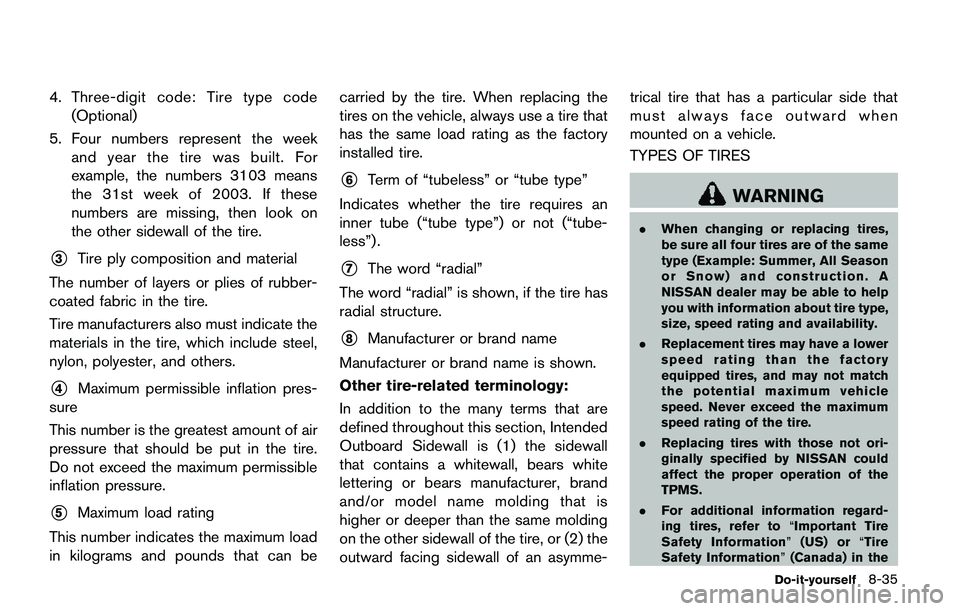
4. Three-digit code: Tire type code
(Optional)
5. Four numbers represent the week
and year the tire was built. For
example, the numbers 3103 means
the 31st week of 2003. If these
numbers are missing, then look on
the other sidewall of the tire.
*3Tire ply composition and material
The number of layers or plies of rubber-
coated fabric in the tire.
Tire manufacturers also must indicate the
materials in the tire, which include steel,
nylon, polyester, and others.
*4Maximum permissible inflation pres-
sure
This number is the greatest amount of air
pressure that should be put in the tire.
Do not exceed the maximum permissible
inflation pressure.
*5Maximum load rating
This number indicates the maximum load
in kilograms and pounds that can becarried by the tire. When replacing the
tires on the vehicle, always use a tire that
has the same load rating as the factory
installed tire.
*6Term of “tubeless” or “tube type”
Indicates whether the tire requires an
inner tube (“tube type”) or not (“tube-
less”) .
*7The word “radial”
The word “radial” is shown, if the tire has
radial structure.
*8Manufacturer or brand name
Manufacturer or brand name is shown.
Other tire-related terminology:
In addition to the many terms that are
defined throughout this section, Intended
Outboard Sidewall is (1) the sidewall
that contains a whitewall, bears white
lettering or bears manufacturer, brand
and/or model name molding that is
higher or deeper than the same molding
on the other sidewall of the tire, or (2) the
outward facing sidewall of an asymme-trical tire that has a particular side that
must always face outward when
mounted on a vehicle.
TYPES OF TIRES
WARNING
.When changing or replacing tires,
be sure all four tires are of the same
type (Example: Summer, All Season
or Snow) and construction. A
NISSAN dealer may be able to help
you with information about tire type,
size, speed rating and availability.
.Replacement tires may have a lower
speed rating than the factory
equipped tires, and may not match
the potential maximum vehicle
speed. Never exceed the maximum
speed rating of the tire.
.Replacing tires with those not ori-
ginally specified by NISSAN could
affect the proper operation of the
TPMS.
.For additional information regard-
ing tires, refer to“Important Tire
Safety Information”(US) or“Tire
Safety Information”(Canada) in the
Do-it-yourself8-35
Page 459 of 508
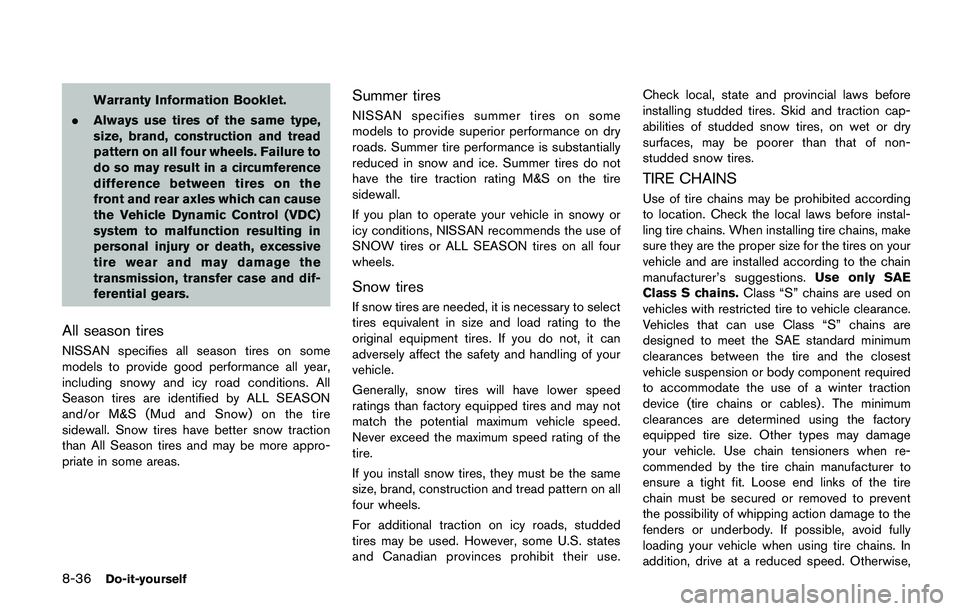
8-36Do-it-yourself
Warranty Information Booklet.
.Always use tires of the same type,
size, brand, construction and tread
pattern on all four wheels. Failure to
do so may result in a circumference
difference between tires on the
front and rear axles which can cause
the Vehicle Dynamic Control (VDC)
system to malfunction resulting in
personal injury or death, excessive
tire wear and may damage the
transmission, transfer case and dif-
ferential gears.
All season tires
NISSAN specifies all season tires on some
models to provide good performance all year,
including snowy and icy road conditions. All
Season tires are identified by ALL SEASON
and/or M&S (Mud and Snow) on the tire
sidewall. Snow tires have better snow traction
than All Season tires and may be more appro-
priate in some areas.
Summer tires
NISSAN specifies summer tires on some
models to provide superior performance on dry
roads. Summer tire performance is substantially
reduced in snow and ice. Summer tires do not
have the tire traction rating M&S on the tire
sidewall.
If you plan to operate your vehicle in snowy or
icy conditions, NISSAN recommends the use of
SNOW tires or ALL SEASON tires on all four
wheels.
Snow tires
If snow tires are needed, it is necessary to select
tires equivalent in size and load rating to the
original equipment tires. If you do not, it can
adversely affect the safety and handling of your
vehicle.
Generally, snow tires will have lower speed
ratings than factory equipped tires and may not
match the potential maximum vehicle speed.
Never exceed the maximum speed rating of the
tire.
If you install snow tires, they must be the same
size, brand, construction and tread pattern on all
four wheels.
For additional traction on icy roads, studded
tires may be used. However, some U.S. states
and Canadian provinces prohibit their use.Check local, state and provincial laws before
installing studded tires. Skid and traction cap-
abilities of studded snow tires, on wet or dry
surfaces, may be poorer than that of non-
studded snow tires.
TIRE CHAINS
Use of tire chains may be prohibited according
to location. Check the local laws before instal-
ling tire chains. When installing tire chains, make
sure they are the proper size for the tires on your
vehicle and are installed according to the chain
manufacturer’s suggestions.Use only SAE
Class S chains.Class “S” chains are used on
vehicles with restricted tire to vehicle clearance.
Vehicles that can use Class “S” chains are
designed to meet the SAE standard minimum
clearances between the tire and the closest
vehicle suspension or body component required
to accommodate the use of a winter traction
device (tire chains or cables) . The minimum
clearances are determined using the factory
equipped tire size. Other types may damage
your vehicle. Use chain tensioners when re-
commended by the tire chain manufacturer to
ensure a tight fit. Loose end links of the tire
chain must be secured or removed to prevent
the possibility of whipping action damage to the
fenders or underbody. If possible, avoid fully
loading your vehicle when using tire chains. In
addition, drive at a reduced speed. Otherwise,
Page 461 of 508
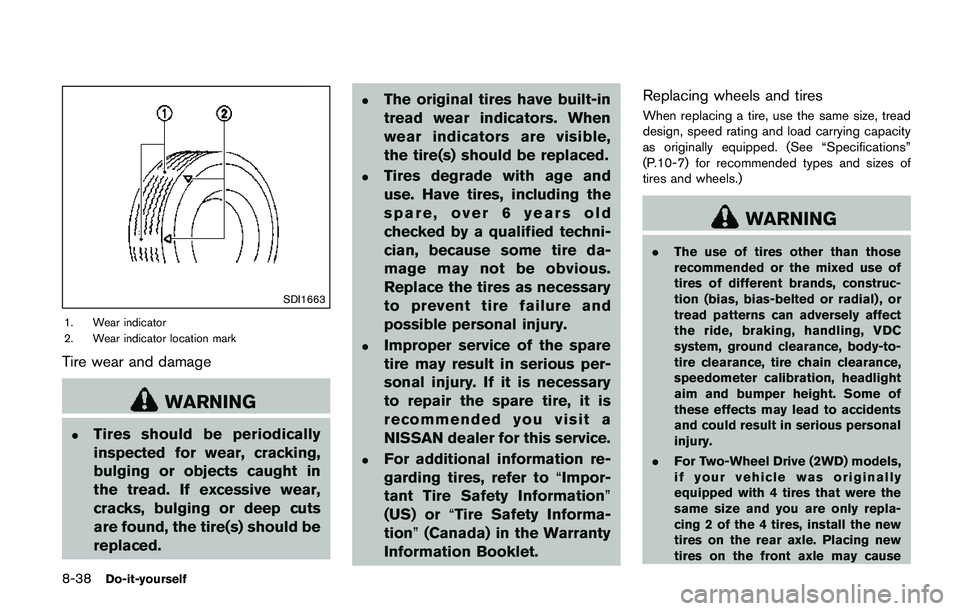
8-38Do-it-yourself
SDI1663
1. Wear indicator
2. Wear indicator location mark
Tire wear and damage
WARNING
.Tires should be periodically
inspected for wear, cracking,
bulging or objects caught in
the tread. If excessive wear,
cracks, bulging or deep cuts
are found, the tire(s) should be
replaced.
.The original tires have built-in
tread wear indicators. When
wear indicators are visible,
the tire(s) should be replaced.
.Tires degrade with age and
use. Have tires, including the
spare, over 6 years old
checked by a qualified techni-
cian, because some tire da-
mage may not be obvious.
Replace the tires as necessary
to prevent tire failure and
possible personal injury.
.Improper service of the spare
tire may result in serious per-
sonal injury. If it is necessary
to repair the spare tire, it is
recommended you visit a
NISSAN dealer for this service.
.For additional information re-
garding tires, refer to“Impor-
tant Tire Safety Information”
(US) or“Tire Safety Informa-
tion”(Canada) in the Warranty
Information Booklet.Replacing wheels and tires
When replacing a tire, use the same size, tread
design, speed rating and load carrying capacity
as originally equipped. (See “Specifications”
(P.10-7) for recommended types and sizes of
tires and wheels.)
WARNING
.The use of tires other than those
recommended or the mixed use of
tires of different brands, construc-
tion (bias, bias-belted or radial) , or
tread patterns can adversely affect
the ride, braking, handling, VDC
system, ground clearance, body-to-
tire clearance, tire chain clearance,
speedometer calibration, headlight
aim and bumper height. Some of
these effects may lead to accidents
and could result in serious personal
injury.
.For Two-Wheel Drive (2WD) models,
if your vehicle was originally
equipped with 4 tires that were the
same size and you are only repla-
cing 2 of the 4 tires, install the new
tires on the rear axle. Placing new
tires on the front axle may cause
Page 462 of 508
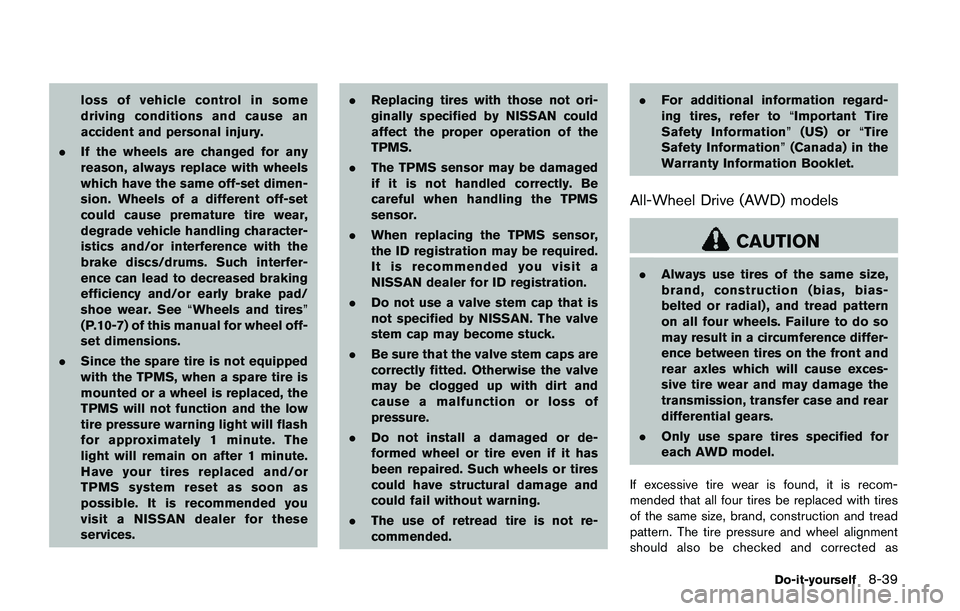
loss of vehicle control in some
driving conditions and cause an
accident and personal injury.
.If the wheels are changed for any
reason, always replace with wheels
which have the same off-set dimen-
sion. Wheels of a different off-set
could cause premature tire wear,
degrade vehicle handling character-
istics and/or interference with the
brake discs/drums. Such interfer-
ence can lead to decreased braking
efficiency and/or early brake pad/
shoe wear. See“Wheels and tires”
(P.10-7) of this manual for wheel off-
set dimensions.
.Since the spare tire is not equipped
with the TPMS, when a spare tire is
mounted or a wheel is replaced, the
TPMS will not function and the low
tire pressure warning light will flash
for approximately 1 minute. The
light will remain on after 1 minute.
Have your tires replaced and/or
TPMS system reset as soon as
possible. It is recommended you
visit a NISSAN dealer for these
services..Replacing tires with those not ori-
ginally specified by NISSAN could
affect the proper operation of the
TPMS.
.The TPMS sensor may be damaged
if it is not handled correctly. Be
careful when handling the TPMS
sensor.
.When replacing the TPMS sensor,
the ID registration may be required.
It is recommended you visit a
NISSAN dealer for ID registration.
.Do not use a valve stem cap that is
not specified by NISSAN. The valve
stem cap may become stuck.
.Be sure that the valve stem caps are
correctly fitted. Otherwise the valve
may be clogged up with dirt and
cause a malfunction or loss of
pressure.
.Do not install a damaged or de-
formed wheel or tire even if it has
been repaired. Such wheels or tires
could have structural damage and
could fail without warning.
.The use of retread tire is not re-
commended..For additional information regard-
ing tires, refer to“Important Tire
Safety Information”(US) or“Tire
Safety Information”(Canada) in the
Warranty Information Booklet.
All-Wheel Drive (AWD) models
CAUTION
.Always use tires of the same size,
brand, construction (bias, bias-
belted or radial) , and tread pattern
on all four wheels. Failure to do so
may result in a circumference differ-
ence between tires on the front and
rear axles which will cause exces-
sive tire wear and may damage the
transmission, transfer case and rear
differential gears.
.Only use spare tires specified for
each AWD model.
If excessive tire wear is found, it is recom-
mended that all four tires be replaced with tires
of the same size, brand, construction and tread
pattern. The tire pressure and wheel alignment
should also be checked and corrected as
Do-it-yourself8-39
Page 486 of 508
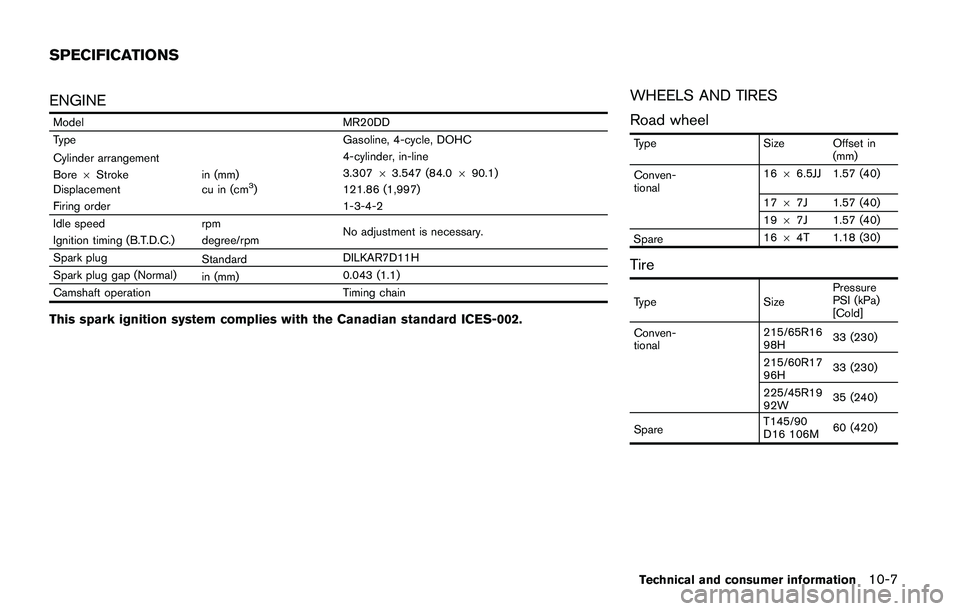
ENGINE
Model MR20DD
Type Gasoline, 4-cycle, DOHC
Cylinder arrangement4-cylinder, in-line
Bore6Stroke in (mm)3.30763.547 (84.0690.1)
Displacement cu in (cm
3) 121.86 (1,997)
Firing order 1-3-4-2
Idle speed rpm
No adjustment is necessary.
Ignition timing (B.T.D.C.) degree/rpm
Spark plug
StandardDILKAR7D11H
Spark plug gap (Normal)
in (mm)0.043 (1.1)
Camshaft operation Timing chain
This spark ignition system complies with the Canadian standard ICES-002.
WHEELS AND TIRES
Road wheel
Type Size Offset in
(mm)
Conven-
tional1666.5JJ 1.57 (40)
1767J 1.57 (40)
1967J 1.57 (40)
Spare1664T 1.18 (30)
Tire
Type SizePressure
PSI (kPa)
[Cold]
Conven-
tional215/65R16
98H33 (230)
215/60R17
96H33 (230)
225/45R19
92W35 (240)
SpareT145/90
D16 106M60 (420)
Technical and consumer information10-7
SPECIFICATIONS
Page 505 of 508
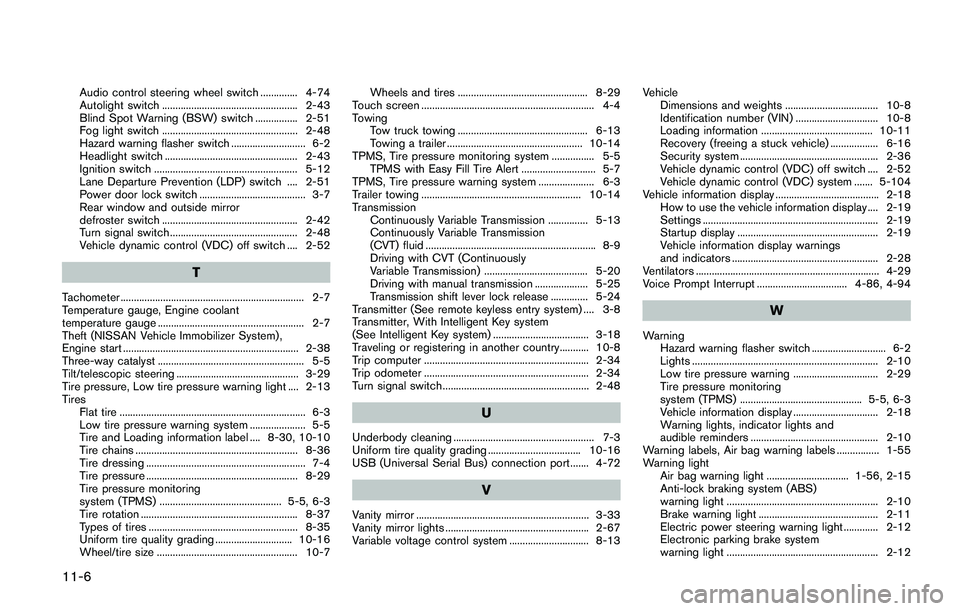
11-6
Audio control steering wheel switch .............. 4-74
Autolight switch ................................................... 2-43
Blind Spot Warning (BSW) switch ................ 2-51
Fog light switch ................................................... 2-48
Hazard warning flasher switch ............................ 6-2
Headlight switch .................................................. 2-43
Ignition switch ...................................................... 5-12
Lane Departure Prevention (LDP) switch .... 2-51
Power door lock switch ........................................ 3-7
Rear window and outside mirror
defroster switch ................................................... 2-42
Turn signal switch ................................................ 2-48
Vehicle dynamic control (VDC) off switch .... 2-52
T
Tachometer ..................................................................... 2-7
Temperature gauge, Engine coolant
temperature gauge ....................................................... 2-7
Theft (NISSAN Vehicle Immobilizer System) ,
Engine start .................................................................. 2-38
Three-way catalyst ....................................................... 5-5
Tilt/telescopic steering .............................................. 3-29
Tire pressure, Low tire pressure warning light .... 2-13
Tires
Flat tire ...................................................................... 6-3
Low tire pressure warning system ..................... 5-5
Tire and Loading information label .... 8-30, 10-10
Tire chains ............................................................. 8-36
Tire dressing ............................................................ 7-4
Tire pressure ......................................................... 8-29
Tire pressure monitoring
system (TPMS) .............................................. 5-5, 6-3
Tire rotation ........................................................... 8-37
Types of tires ........................................................ 8-35
Uniform tire quality grading ............................. 10-16
Wheel/tire size ..................................................... 10-7Wheels and tires ................................................. 8-29
Touch screen ................................................................. 4-4
Towing
Tow truck towing ................................................. 6-13
Towing a trailer ................................................... 10-14
TPMS, Tire pressure monitoring system ................ 5-5
TPMS with Easy Fill Tire Alert ............................ 5-7
TPMS, Tire pressure warning system ..................... 6-3
Trailer towing ............................................................ 10-14
Transmission
Continuously Variable Transmission ............... 5-13
Continuously Variable Transmission
(CVT) fluid ................................................................ 8-9
Driving with CVT (Continuously
Variable Transmission) ....................................... 5-20
Driving with manual transmission .................... 5-25
Transmission shift lever lock release .............. 5-24
Transmitter (See remote keyless entry system) .... 3-8
Transmitter, With Intelligent Key system
(See Intelligent Key system) .................................... 3-18
Traveling or registering in another country........... 10-8
Trip computer .............................................................. 2-34
Trip odometer .............................................................. 2-34
Turn signal switch ....................................................... 2-48
U
Underbody cleaning ..................................................... 7-3
Uniform tire quality grading ................................... 10-16
USB (Universal Serial Bus) connection port ....... 4-72
V
Vanity mirror ................................................................. 3-33
Vanity mirror lights ...................................................... 2-67
Variable voltage control system .............................. 8-13Vehicle
Dimensions and weights ................................... 10-8
Identification number (VIN) ............................... 10-8
Loading information .......................................... 10-11
Recovery (freeing a stuck vehicle) .................. 6-16
Security system .................................................... 2-36
Vehicle dynamic control (VDC) off switch .... 2-52
Vehicle dynamic control (VDC) system ....... 5-104
Vehicle information display ....................................... 2-18
How to use the vehicle information display .... 2-19
Settings .................................................................. 2-19
Startup display ..................................................... 2-19
Vehicle information display warnings
and indicators ....................................................... 2-28
Ventilators ..................................................................... 4-29
Voice Prompt Interrupt .................................. 4-86, 4-94
W
Warning
Hazard warning flasher switch ............................ 6-2
Lights ...................................................................... 2-10
Low tire pressure warning ................................ 2-29
Tire pressure monitoring
system (TPMS) .............................................. 5-5, 6-3
Vehicle information display ................................ 2-18
Warning lights, indicator lights and
audible reminders ................................................ 2-10
Warning labels, Air bag warning labels ................ 1-55
Warning light
Air bag warning light ............................... 1-56, 2-15
Anti-lock braking system (ABS)
warning light ......................................................... 2-10
Brake warning light ............................................. 2-11
Electric power steering warning light ............. 2-12
Electronic parking brake system
warning light ......................................................... 2-12